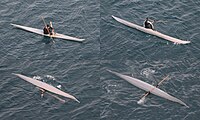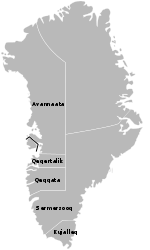Qaanaaq
Qaanaaq
Thule | |
|---|---|
 Qaanaaq | |
| Kingdom | Denmark |
| Country | |
| Municipality | Qaasuitsup |
| First settled | 2000 BC |
| Population (2010) | |
| • Total | 626 |
| Time zone | UTC-04 |
| Postal code | 3971 |
Qaanaaq (Greenlandic pronunciation: [qaːnaːq]), formerly Thule or New Thule, is the main town in the northern part of the Qaasuitsup municipality in northwestern Greenland. It is one of the northernmost towns in the world. The inhabitants of Qaanaaq speak Kalaallisut and many also speak Inuktun. The town has a population of 626 as of 2010.[1] The tallest construction in Greenland, the 378-meter Globecom Tower (Radio Mast Thule), is located near the town.[2][3]
History

The Qaanaaq area in northern Greenland was first settled 2000 BC by the Paleo-Eskimo migrating from the Canadian Arctic.[4]
The town of Qaanaaq was established in the winter of 1953 when the United States expanded their airbase at Thule and forcibly relocated the population of Pituffik, Dundas, and Uummannaq 31 km (19 mi) to the north within four days during the height of the Cold War. The settlement was subsequently moved another 100 kilometers to the north.
Culture
Ways of living so far north and in such severe climatic conditions are passed on from generation to generation, and this ability to adapt has contributed to the survival of this small community. When the sea becomes open sometime around August, large dinghies with powerful engines are used for both hunting trips and ordinary journeys. It is still light twenty-fours hours a day at this time - the Midnight Sun lasts from the middle of April to the end of August. Nothing from the hunt goes to waste: the skins are used for clothing and covering the kayaks; the flesh and offal are eaten by humans and domestic animals; the narwhal and walrus tusks are carved into finely-worked figures, jewellery and hunting implements, and even feathers can be used in handicrafts.[citation needed]
Transport
Air Greenland operates fixed-wing aircraft services between Qaanaaq Airport and Upernavik Airport, with further connections to Ilulissat Airport and Qaarsut Airport. Settlement flights operate to Siorapaluk, sporadically to Moriusaq, and to Savissivik via Thule Air Base.[5]
Population
With 626 inhabitants as of 2010, Qaanaaq is the largest settlement in the far north of the country.[6] Its population has been relatively stable over the last two decades, increasing by more than 13 percent relative to the 1990 levels.[6]
Climate
Qaanaaq has a polar climate (Köppen "Polar tundra") and hence has long, cold winters. Peak temperatures occur in July and seldom exceed 10ºC.
| Climate data for Qaanaaq | |||||||||||||
|---|---|---|---|---|---|---|---|---|---|---|---|---|---|
| Month | Jan | Feb | Mar | Apr | May | Jun | Jul | Aug | Sep | Oct | Nov | Dec | Year |
| Record high °C (°F) | 5 (41) |
1 (34) |
2 (36) |
6 (43) |
12 (54) |
20 (68) |
19 (66) |
17 (63) |
10 (50) |
5 (41) |
3 (37) |
3 (37) |
20 (68) |
| Mean daily maximum °C (°F) | −20 (−4) |
−22 (−8) |
−20 (−4) |
−13 (9) |
−3 (27) |
3 (37) |
7 (45) |
5 (41) |
1 (34) |
−7 (19) |
−14 (7) |
−18 (0) |
−8 (18) |
| Mean daily minimum °C (°F) | −27 (−17) |
−29 (−20) |
−28 (−18) |
−21 (−6) |
−8 (18) |
1 (34) |
2 (36) |
1 (34) |
−5 (23) |
−13 (9) |
−21 (−6) |
−25 (−13) |
−15 (5) |
| Record low °C (°F) | −40 (−40) |
−58 (−72) |
−41 (−42) |
−34 (−29) |
−22 (−8) |
−7 (19) |
−3 (27) |
−6 (21) |
−17 (1) |
−31 (−24) |
−33 (−27) |
−46 (−51) |
−58 (−72) |
| Average precipitation mm (inches) | 3 (0.1) |
3 (0.1) |
3 (0.1) |
3 (0.1) |
3 (0.1) |
5 (0.2) |
13 (0.5) |
13 (0.5) |
10 (0.4) |
3 (0.1) |
3 (0.1) |
5 (0.2) |
67 (2.5) |
| Average rainy days | 0 | 0 | 0 | 0 | 0 | 1 | 2 | 2 | 1 | 0 | 0 | 0 | 6 |
| Source 1: Weatherbase[7] | |||||||||||||
| Source 2: BBC Weather[8] | |||||||||||||
References
- ^ Statistics Greenland, Greenland in Figures, 2010
- ^ Thule Radio Mast
- ^ Snippet from "Thule Times" – Thuleforum
- ^ Fortescue, Michael. Language Relations Across Bering Strait: Reappraising the Archaeological and Linguistic Evidence. Open Linguistic Press, Cassell, 1998. ISBN 0-304-70330-3
- ^ "Booking system". Air Greenland. Retrieved 9 June 2010.
- ^ a b c Statistics Greenland
- ^ Qaanaaq. Retrieved 25 January 2010.
- ^ [1]. Retrieved 23 December 2011.
Further reading
- Murray, Louise. 2006. "On Thin Ice – Louise Murray Travels to Qaanaaq in Northern Greenland to See the Effect That Climate Change Is Having on Subsistence Hunters and Their Prey". Geographical : the Royal Geographical Society Magazine. 32.
- Remie, C. H. W. Facing the Future Inughuit Youth of Qaanaaq : Report of the 1998 University of Nijmegen Student Expedition to Qaanaaq, Thule District, Northern Greenland. Nijmegen: Nijmegen University Press, 1999. ISBN 90-5710-078-9
External links


